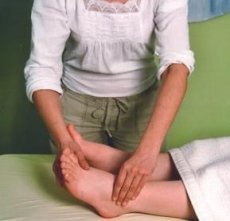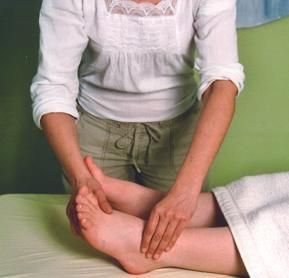Medical expert of the article
New publications
Foot injuries from running activities
Last reviewed: 07.07.2025

All iLive content is medically reviewed or fact checked to ensure as much factual accuracy as possible.
We have strict sourcing guidelines and only link to reputable media sites, academic research institutions and, whenever possible, medically peer reviewed studies. Note that the numbers in parentheses ([1], [2], etc.) are clickable links to these studies.
If you feel that any of our content is inaccurate, out-of-date, or otherwise questionable, please select it and press Ctrl + Enter.

Foot injuries can occur when wearing the "wrong" shoes or under heavy loads. What types of arch injuries are there and what to do about them? The right attitude to the problem is the key to its solution.

Pain in the foot
It happens that during intense exercise a person can feel unpleasant and quite severe pain. Pain in the plantar region occurs due to several reasons: be it a sprained ligament or a sprained tendon. Sometimes pain in the plantar part of the foot can occur due to a disease called "plantar fasciitis".
Unlike sprains, plantar fasciitis occurs because you have flat feet.
Both diseases are equally important, and you can’t ignore foot pain, as it promises more severe pain in the future. Create and maintain a sports regimen that you have established so that the arch gets some support, reduce the load on the sore part of the foot. The place where your foot hurts should be tightly wrapped with a bandage. If for some reason you need to constantly be in motion, stick a plaster on the affected area of the foot.
Ankle sprains
Many people suffer from ankle sprains. The cause of such an injury can be running or falling. There are even people who can sprain their ankles a couple of times a week. They need to take care of their feet more than the rest of their feet.
Achilles tendon injuries
People who have suffered an Achilles tendon injury are well aware of how long such an injury can be accompanied by pain. And most importantly, how difficult it is to heal.
 [ 4 ], [ 5 ], [ 6 ], [ 7 ], [ 8 ]
[ 4 ], [ 5 ], [ 6 ], [ 7 ], [ 8 ]
What is the Achilles tendon and how can it be injured?
The Achilles tendon is nothing more than a huge, heavy tendon that sits on the lower back of your leg. Achilles tendon injury occurs due to excessive strain on the calf muscles. Let's imagine that it's summer and you've decided to go for your usual jog around town or the park. You take a deep breath, stand up straight, and run at full speed. You forgot to take into account that after the winter break, your muscles are not adapted to long-term strain. It's even possible that you won't be able to run properly for several weeks after your first run.
When bending the sole, there may be a large swelling of the calf muscles or inflammation, pain when bending the foot. If you put a thick cloth under the heel, the cloth should fit tightly to the heel on the sore leg and cushion when walking. The thickness of this cloth should be approximately 50 millimeters. Wear such an insert for a long time, namely 6 weeks. Such an insert is worn not only during sports and exercise, but also in a normal environment. The pain will gradually go away, but the main thing is not to shorten the wearing period, it is determined by specialists.
Remember to do compound exercises to keep your ligaments and tendons loose and stretched.
If you still managed to tear your Achilles tendon, you need to follow the recommendations of a traumatologist and rest as much as possible. And then foot injuries will bother you much less often.
You need to see a doctor
If the injury to the arch of the foot is serious enough, this method of treatment did not help you, you should immediately contact a doctor - an orthopedist. Perhaps you will have to wear orthopedic bandages and be treated differently.
Prevention of arch injury
From what you have in your first aid kit, find either a band-aid or use sticky tape - either will do. Carefully cut a strip of tape about 20 cm long, the width of such a tape should be 4-5 centimeters. Stick part of the tape to the outside of your foot. Then, under the foot, pressing the tape tightly, stick the opposite end of your tape to the inside of the foot, namely, the inside of the instep. Most importantly, do not wrap the tape around the tendon that belongs to the big toe. Otherwise, the bandage will be ineffective and will hinder your walking or running. Stick the second strip in the same way as the first, only you should take into account the overlap - 1 centimeter.
Preventing Ankle Sprains
In order not to suffer from constant or frequent ruptures, stretches - warm up and stretch the ligaments on the foot. Even before a regular walk around the city, it is necessary to do such exercises for greater elasticity of the foot.
Here is one such effective exercise. You need to sit on a chair and comfortably place the ankle of your left leg on the knee of your right leg, you should completely relax your muscles and grab the joints of your leg with your hands. Take your right leg in your right hand and repeat the circular movements several times, then rotate the foot in the opposite direction.
Perform circular movements for 30 seconds or more. After such exercises, you will feel the blood rushing to your legs, and the joints stretching and relaxing. After this, bend your foot inward as much as possible to stretch the outer ligaments of the foot joints. Try to hold your foot in this position for a certain time, then release. After the muscles are completely relaxed, do the same exercise for the other foot.
Benefits of Stretching
The benefits of stretching the ankle joints are amazing. Even if you consider that the exercises last about 3-4 minutes, they can help get rid of even limping, pain and fatigue in the legs. After such exercises, your gait will become easier and more relaxed, and you will be more confident.
Under the Burden of Training
If you are prone to ankle sprains and have a tough workout ahead of you (cross-country running, etc.), you should tightly wrap your ankle with an elastic bandage or tape. An elastic bandage is a great preventative even for people prone to ankle injuries, and will be a great protection for everyone.
If an injury occurs
If your leg has been injured, no matter how, you should give it some rest. Your legs deserve a rest after heavy loads. The first thing you will need to do is to keep your leg elevated so that the blood leaves it. Then you need to apply an elastic bandage to the injured joint of the leg. Then apply ice to the sore area of the leg.
For two days, perform a minimum of movements, according to the prescribed program during the period when you are immobilized, gradually stretch the sore leg. If the ankle injury is repeated repeatedly, you should consult an orthopedic doctor for advice and treatment.
If you have an injury, soak a towel in cool water and place it on the injured leg. Wait until the pain subsides a little. Do not try to train through pain, give your leg peace and rest.
Healing Arnica for Ankle Sprains
When spraining an ankle, it is best to use arnica, also called mountain daisy. Rub creams with arnica into the affected areas of the ankle or soak napkins with an infusion of this plant and apply them to the sore spot. Gradually healing the ankle will not take long.
Interesting facts about the ankle
Check your own ankle, how it is constructed. Take your worn, old shoes and look closely at which way your heel leans. If it leans inward, it means that your foot is turned outward more than inward. With this feature, the ligaments of the inner joints are tense and stretched, and the outer ones, on the contrary, are shortened. With a small load, a sprain is quite possible, and in some cases, a ligament rupture.

